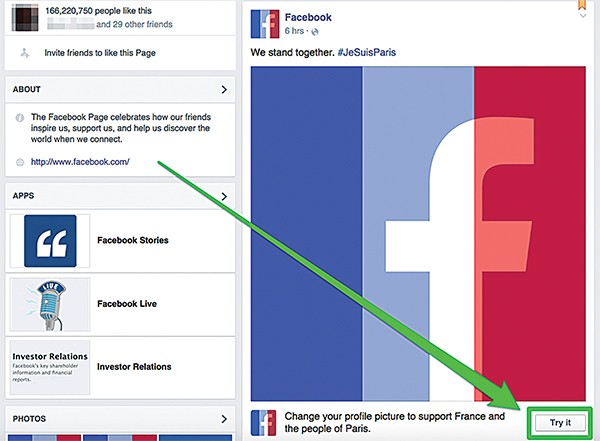November is supposed to be a time of gratitude, when we gather round and reflect on all the good things and people in our lives. But in the wake of last week’s tragedy in Paris, plus the recent loss of a friend, I’ve spent a lot of time pondering grief. How do I process these emotions, and how do I respond? How can I help others find comfort in painful situations? How can I best serve the memory of those who are gone?
These are questions we can answer only for ourselves. And, apparently, our Facebook friends.
Last Friday afternoon, as we watched the horrific events in Paris unfold, the social media reaction came in waves. First came the photos of friends in front of the Eiffel Tower, sharing their concern and offering their prayers. Then, the blue, white, and red profile photos.

Outward expressions of sympathy and support are perfectly acceptable responses! Anger, confusion, and frustration are understandable as well. But what came next troubled me. I’m not talking about the Obama-blamers or Donald Trump’s shock-value pander-babble or the “bomb ’em all” crowd. I am used to all that. No, it’s the Grief Police that have convinced me that the Internet has made monsters of us all.
“Where was the outrage over (insert other issue here)?” “Why is there no flag for (insert country here)?” “What is France going to do with your thoughts and prayers?” “Do you people really think changing your profile picture is going to do anything?”
It can be a burden, but it is possible to care about more than one thing at a time. There is a veritable cornucopia of issues to lose sleep over. I usually am outraged about at least three different things, and that’s on a good day. I’m sure most of France appreciates the thoughts, prayers, and gestures. I doubt anyone at ISIS headquarters has decided to give up the terrorist life after logging in to Facebook and seeing the shows of solidarité. All of this is beside the point, which is: Don’t tell people how to be sad.
Grief is a process that all of us approach differently. There are healthy approaches, but there is no single correct approach.
Of course, that did not stop me from considering whether I should change my Facebook picture, lest anyone suspect me of being unsympathetic. Because if something terrible happens and you don’t post about it on the Internet, how will anyone know you care?
How did we grieve before Facebook and Twitter? Where did we offer our #ThoughtsAndPrayers in times of tragedy? Is wearing black the analog version of a changed profile picture or a pithy meme? And how on Earth were we able to judge others when we perceived them to be processing their sadness in the “wrong” manner? Is this brand of shaming a new phenomenon like Tinder and selfie sticks? Or has it been happening all along, just in beauty parlors and sewing circles and Letters to the Editor?
Social media provides a space for people to grieve together in spite of physical distance. Seeing and sharing anecdotes and photos and well-wishes can be therapeutic. Or it can be overwhelming. It might be #toosoon. It might fill you with regret or remorse or sometimes even resentment. But that’s your response. We all have emotional baggage, but the contents vary. Each of us carries our baggage in our own way.
There is so much ugliness in the world. And we’re exposed to so much more of it thanks to the myriad technologies we have at our fingertips. Let’s not compound it by being assholes to each other on the Internet when people are hurting. There’s not a whole lot we can control, but one thing we can control is the way we treat others.
Be thankful for that.
Jen Clarke is an unapologetic Memphian and digital marketing strategist.